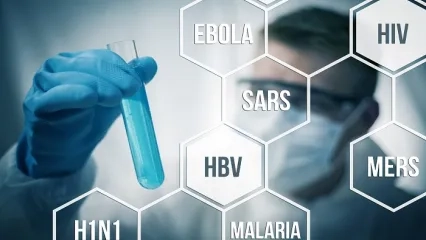Alo Yeditepe
Alo Yeditepe
What is COVID-19?
Coronaviruses are RNA viruses that can infect humans and a wide range of animal species. In humans, they cause a wide range of respiratory infections, from the common cold to pneumonia. Every year in autumn and winter, coronaviruses cause the common cold, which is characterized by sore throat, dry cough, runny nose, weakness, and fatigue at -35%. The incubation period is 3-5 days and in such coronavirus infections, the disease is self-limiting within 4-6 days and patients recover rapidly. Pneumonia may develop in a very small proportion of cases, especially in the risk group.
Different from the Common Cold
Since 2002, new coronavirus strains have started to be seen with a more severe respiratory tract infection that is different from the common cold, almost flu-like. The first of these is SARS-CoV (Severe Acute Respiratory Syndrome Coronavirus). In February 2003, the disease, which was first thought to have been transmitted from bats to palm civet cats and then to humans in the Guangdong region of China in February 2003, affected 8000 people in 33 countries from 5 continents, mostly from China, in 8 months, and approximately 800 people died from this disease. After 2004, no new cases of SARS have been reported.
Elderly Patients and People with Chronic Diseases
Another new coronavirus infection is MERS-CoV (Middle East Respiratory Syndrome corona virus). It first started in Saudi Arabia in 2012. This different MERS-CoV outbreak, which was transmitted from camel to human and continued until June 2018, was detected in 2229 cases in 5 continents and 27 different countries. 791 of these cases died. While the mortality rate was 9.6% in SARS-CoV, it reached 35% in MERS-CoV. The incubation period for both SARS-CoV and MERS-CoV infections can be as short as 3-5 days or as long as 10-14 days. This means that you can transmit the disease to others for up to 10-14 days before symptoms appear. After the incubation period, the disease progresses with complaints of high fever, sore throat, dry cough, respiratory failure, muscle, and joint pain, and headache. Since the disease mostly causes damage to the lower respiratory tract, pneumonia is more common and this can be life-threatening, especially in elderly patients who are considered to be at risk, or in those with underlying chronic heart, lung, or kidney disease. For those who recover from the disease, the recovery process can take up to 7-10 days.
It Can Stay in the Respiratory Tract for 2-3 Weeks
In coronavirus infections that progress as a common cold, the virus infects ciliated epithelial cells in the nasopharynx through aminopeptidase N receptor or sialic acid receptors. As the virus multiplies, the destruction of the ciliated squamous epithelial cells develops. Secreted chemokines and interleukins cause the development of local symptoms. SARS-CoV and MERS-CoV bind to respiratory tract cells via angiotensin-converting enzyme 2. This causes systemic infectious disease. The virus can also pass into pneumocytes, blood, urine (up to 2 months), and feces. In the respiratory tract, the virus can be present for 2-3 weeks.
On December 31, 2019, a case reported from Wuhan, a city with a population of 11 million in China's Hubei province, was found to be infected with a new coronavirus that has never been seen before. This virus, named 2019-nCoV, is thought to be a zoonotic infection, i.e. transmitted from animals to humans, like SARS-CoV and MERS-CoV. Now, the disease is rapidly spreading from person to person and on January 30, 2020, the number of cases reached 8000, most of them in Hubei province, especially in Wuhan, and in 19 other countries outside China, and 170 cases died, all in China. When the cases that lost their lives were analyzed, it was found that the majority of them were elderly patients or patients with chronic heart, lung, and kidney disease, Parkinson's disease, and diabetes.
What is the 2019-Ncov Transmission Pathway?
The infection, which started in the city of Wuhan, is thought to have probably been transmitted from a market where seafood and various wild animal meat products were also sold. Human-to-human transmission of the disease is now proven. So far, transmission has been most common in people who have been in the same family or environment as the infected person, and in healthcare workers who have not taken droplet precautions. Transmission usually occurs when droplets from the coughing and sneezing of a sick person enter the respiratory tract of unprotected people in close contact up to 1 m away.
2019-Does Ncov Continue to Live in the Environment?
Within the framework of the current information, although it is accepted that the possibility of transmission of 2019 nCoV through hands after hand contact with inanimate surfaces in outdoor conditions is weak, it should not be neglected to wash hands or clean them with alcohol-based hand sanitizers and wipe inanimate surfaces after contact with living or inanimate surfaces with hands.
What are the Symptoms of 2019-Ncov?
What is known for now is that infected patients complain of cough, high fever, and respiratory distress, and in severe cases, respiratory failure, renal failure, and life-threatening multi-organ failure may develop.
Who Has a Severe Course?
2019 nCoV infection, like seasonal influenza, tends to be more severe and life-threatening in elderly patients or those with underlying chronic heart disease, lung disease, and chronic kidney and liver disease, regardless of age.
How Does the Disease Progress?
Based on current knowledge, it is not possible to make a definite conclusion about how and how fast the disease may progress. However, related studies are ongoing. The disease may start to appear in regions or countries where it has not been seen before. The number of patients may even increase significantly, but this does not mean that the disease will be more severe or have a higher mortality rate.
How to Approach Possible or Definite Patients?
Patients with high fever, dry cough, and respiratory distress in the Hubei province of China and especially in Wuhan city, where the disease started within the last 14 days, are called probable cases, and those with these complaints and in whom the causative agent is detected from respiratory tract samples by the microbiological method are called definite cases. It is important for such cases to report their condition to the health institution by phone and to be evaluated by the health teams at home rather than going directly to the health institution themselves in order to prevent the spread of infection in the community. Cases to be evaluated at home should wear a mask covering their mouth and nose and the healthcare team should evaluate the case by wearing masks, gloves, and other protective equipment with high protective properties.
Bringing patients who require hospitalization to the health institution with a mask and hospitalizing patients with possible and/or definite 2019 nCoV infection in negative pressure rooms and separating the healthcare team that will serve this can be considered among the approaches that should be implemented.
Is There a Cure for Corona Disease?
There are currently no antiviral drugs to treat the disease. Antiviral drugs used in the treatment of other viral infections have been tried in the treatment of coronavirus infections, but no effective results have been obtained. For the time being, treatment is symptomatic and bed rest, plenty of fluid consumption, and daily calorie intake are necessary for body resistance. Because it is body resistance that will cure the disease.
This content was prepared by Yeditepe University Hospitals Medical Editorial Board.
”
See Also
- Infections Common in Hot Weather
- What is Hepatitis B? What are its symptoms? How is it Transmitted?
- What is HMPV Virus? HMPV Symptoms and Ways of Transmission
- Why Is the Flu Lasting Longer This Year?
- What is West Nile Virus? What are the Symptoms and how is it Transmitted?
- Viral Hepatitis and Prevention Methods
- What Precautions Should Be Taken Against the Cold Epidemic?
- Don't Be Late Fighting Against Diseases
- Antibiotics Kill Beneficial Bacteria, Not Viruses
- What is Hepatitis? What are the Symptoms and Treatment Methods?
- Symptoms and Treatment of Tick Bites
- Summer Infections
- Precautions Must Be Taken Against Loss of Life Due To Infection in Thalassemia
- Information on H1N1 (Swine Flu)
- Summer is Coming... Beware of food poisoning!
- Office Hygiene: The Most Common Areas Where Microbes are Found in the Office
- Our Taboos Affect the Increase in the Number of HIV-Positive Cases in Turkey
- Strep A Symptoms and Treatment
- Do Not Put a Cigarette Butt or Pour Olive Oil or Liquid Soap on the Tick
- Reheat the Food You Cooked Only Once!
- HIV Can Be Hidden for 10 Years without Any Symptoms!
- 290 Million People Live Without Knowing They Have Hepatitis
- Things to Consider When Touching Meat at Eid
- What Is Anthrax Disease?
- The Way to Fight AIDS is to Raise Awareness First
- Still Not Too Late For Flu Vaccine
- What is Rhinovirus?
- Fighting with Thalassemia: Meral Yılmaz
- Thalassemia Spreads from the Mediterranean to the Whole of Europe with Migration!
- Early Treatment of Crimean Congo Hemorrhagic Fever is Vital
- Approximately 3 Million Patients Need Blood Transfusions Every Year in Turkey
- When to Get the Flu Vaccine
- Antibiotics Account For 14% of Prescription Costs
- West Nile Virus Replaces Malaria
- It Is Necessary to Try to Be Healthy in order to Be Protected
- A New Flu Outbreak is Expected Every 10 Years
- 63% of Vector-Borne Diseases are Caused by Lyme Disease
- Experts Warn About Flu Risk
- Mosquito Infection Risk
- Why aren’t Antibiotics Working Any More?
- The World Raises an “Alarm” on Antibiotic Resistance!
- The Mask Requirement was Removed and the Importance of Social Distance Increased!
- How to Prevent COVID-19 in School-Going Children
- WHO (World Health Organization) Warns for Antibiotic Resistance!
- Who Is Threatened by Monkeypox?
- Ways to Prevent Coronavirus
- Swine Flu / H1N1
- Life Returns to Normal with Caution
- What is Monkeypox Virus? What Are the Symptoms of the Monkeypox Virus?
- What is Lyme Disease?
- How to Tell if You Have a Mild Coronavirus?
- Pay Attention to These Rules for COVID-19
- Hand Sanitizer Usage Guide
- The Priority Rule for the Protection from Summer Infections is Hygiene
Alo Yeditepe




